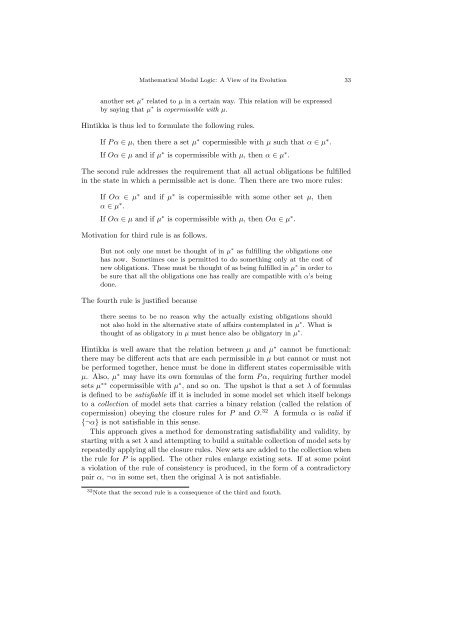MATHEMATICAL MODAL LOGIC: A VIEW OF ITS EVOLUTION
MATHEMATICAL MODAL LOGIC: A VIEW OF ITS EVOLUTION
MATHEMATICAL MODAL LOGIC: A VIEW OF ITS EVOLUTION
You also want an ePaper? Increase the reach of your titles
YUMPU automatically turns print PDFs into web optimized ePapers that Google loves.
Mathematical Modal Logic: A View of its Evolution 33another set µ ∗ related to µ in a certain way. This relation will be expressedby saying that µ ∗ is copermissible with µ.Hintikka is thus led to formulate the following rules.If P α ∈ µ, then there a set µ ∗ copermissible with µ such that α ∈ µ ∗ .If Oα ∈ µ and if µ ∗ is copermissible with µ, then α ∈ µ ∗ .The second rule addresses the requirement that all actual obligations be fulfilledin the state in which a permissible act is done. Then there are two more rules:If Oα ∈ µ ∗ and if µ ∗ is copermissible with some other set µ, thenα ∈ µ ∗ .If Oα ∈ µ and if µ ∗ is copermissible with µ, then Oα ∈ µ ∗ .Motivation for third rule is as follows.But not only one must be thought of in µ ∗ as fulfilling the obligations onehas now. Sometimes one is permitted to do something only at the cost ofnew obligations. These must be thought of as being fulfilled in µ ∗ in order tobe sure that all the obligations one has really are compatible with α’s beingdone.The fourth rule is justified becausethere seems to be no reason why the actually existing obligations shouldnot also hold in the alternative state of affairs contemplated in µ ∗ . What isthought of as obligatory in µ must hence also be obligatory in µ ∗ .Hintikka is well aware that the relation between µ and µ ∗ cannot be functional:there may be different acts that are each permissible in µ but cannot or must notbe performed together, hence must be done in different states copermissible withµ. Also, µ ∗ may have its own formulas of the form P α, requiring further modelsets µ ∗∗ copermissible with µ ∗ , and so on. The upshot is that a set λ of formulasis defined to be satisfiable iff it is included in some model set which itself belongsto a collection of model sets that carries a binary relation (called the relation ofcopermission) obeying the closure rules for P and O. 32 A formula α is valid if{¬α} is not satisfiable in this sense.This approach gives a method for demonstrating satisfiability and validity, bystarting with a set λ and attempting to build a suitable collection of model sets byrepeatedly applying all the closure rules. New sets are added to the collection whenthe rule for P is applied. The other rules enlarge existing sets. If at some pointa violation of the rule of consistency is produced, in the form of a contradictorypair α, ¬α in some set, then the original λ is not satisfiable.32 Note that the second rule is a consequence of the third and fourth.
















